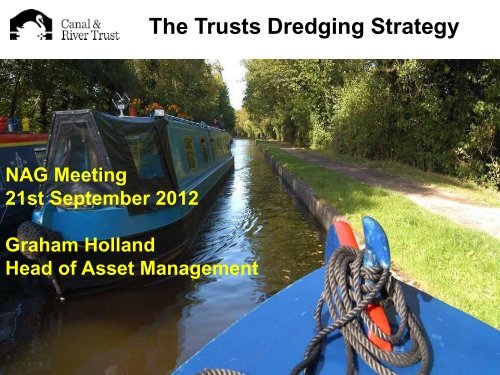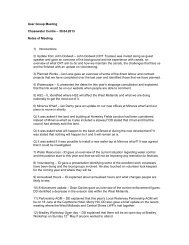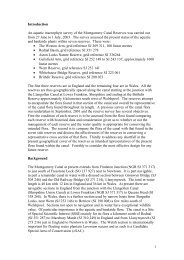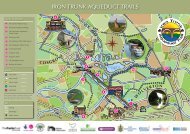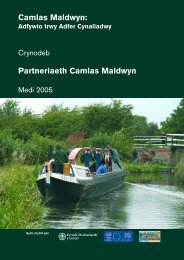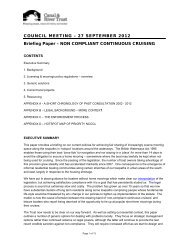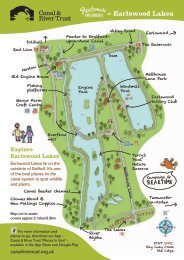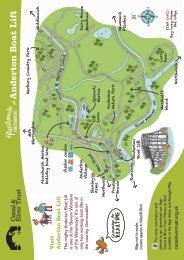The Trusts Dredging Strategy - Canal & River Trust
The Trusts Dredging Strategy - Canal & River Trust
The Trusts Dredging Strategy - Canal & River Trust
- No tags were found...
You also want an ePaper? Increase the reach of your titles
YUMPU automatically turns print PDFs into web optimized ePapers that Google loves.
<strong>The</strong> <strong><strong>Trust</strong>s</strong> <strong>Dredging</strong> <strong>Strategy</strong>NAG Meeting21st September 2012Graham HollandHead of Asset Management
<strong>The</strong> <strong><strong>Trust</strong>s</strong> <strong>Dredging</strong> <strong>Strategy</strong>Current Review – Why Now?• Previous practices not always well defined• Processes – required greater clarity• <strong>The</strong> need to apply asset management rigour to decisions in linewith the requirements of AMP12/PAS55 – risk management
<strong>The</strong> <strong><strong>Trust</strong>s</strong> <strong>Dredging</strong> <strong>Strategy</strong><strong>Dredging</strong> methods• Traditional excavation using floating plant and hoppers - normal• Land based excavators possible if access allows - rare• Water Injection <strong>Dredging</strong> (<strong>River</strong>s, G&S)• Cutter Suction <strong>Dredging</strong> - rare• Hoeing and Raking – <strong>River</strong>s, and occasional for weed and debris removal• Spot dredging – often high unit costs due to site set upTreatment & Disposal• On-site treatment to lower water content by vacuum, centrifuge, lime, mixing,spreading, drying – expensive, laborious and may increase disposal volumes.• Disposal as on-site backfill to piles or bank protection - preferred• Disposal to local agricultural land – environmental legislation• Disposal to licensed <strong>Trust</strong> owned tip – few left with adequate capacity• Disposal to licensed waste site – few available in UK, large transport costs
COSTS• Expensive – generally£100k/km to +£500k/km• Waste Regs. making thisincreasingly expensive(doubled 2003 to 2006)• Series of Acts andRegulations 1998 to 2005– still continuing – <strong>Trust</strong>not exempt in any way• Traditional disposal tolandfill or to banks andbehind bank protectionpreferred• Liquid waste now bannedso pre-treatment required- lime, centrifuge, PFA<strong>The</strong> <strong><strong>Trust</strong>s</strong> <strong>Dredging</strong> <strong>Strategy</strong>
8 year cycle – full network<strong>The</strong> <strong><strong>Trust</strong>s</strong> <strong>Dredging</strong> <strong>Strategy</strong>Identification - Hydrographic SurveySingle Point Sonar surveys• GPS Controlled Single Point echo sounding - forreservoir, dock and tidal surveys.• Survey output - contour bed plan, digital terrainmodel, enables volume calculations for dredging andreservoir capacity.Scanning Sonar Profiler surveys• GPS Controlled Scanning profiler - collects a ‘swathe’of data across the canal bed. Many 1000’s of points.• Allows extraction of cross sections extracted at anypoint• Cross section data used to calculate <strong>Dredging</strong>Priority Trigger (DPT) compliance
<strong>The</strong> <strong><strong>Trust</strong>s</strong> <strong>Dredging</strong> <strong>Strategy</strong>Onboard Display<strong>River</strong> Aire –Section locationOn-board display of section of<strong>River</strong> Aire
<strong>The</strong> <strong><strong>Trust</strong>s</strong> <strong>Dredging</strong> <strong>Strategy</strong>Survey Report OutputsContour chart and ‘run line’ survey ofthe <strong>River</strong> Mersey at Liverpool DocksapproachColour DTM of Brent Reservoir showingrelic river channel running through centre ofreservoir
• Controlling water levelestablished to ensureaccuracy andrepeatability of survey.• GPS height and positionfound on controlling weir,to accuracy of
<strong>The</strong> <strong><strong>Trust</strong>s</strong> <strong>Dredging</strong> <strong>Strategy</strong>Cross Section Analysis• MOC ‘trigger’ box sections developed in late 1990’s. Terminology confusing• Now changing to <strong>Dredging</strong> Priority Trigger (DPT) box• Cross sections extracted from survey data every 50m and DPT box ‘driven’ over eachcross section• 95% of DPT box must be clear from silt blockage at the ‘best-fit’ location.• Formerly 70% of cross sections in each km must meet the DPT requirement to becompliant - changed to 90% - much tougher testFailing SectionPassing Section
<strong>The</strong> <strong><strong>Trust</strong>s</strong> <strong>Dredging</strong> <strong>Strategy</strong>Current 70/30 DPT Compliance Map• Visual display of DPT• Passing lengths shown ingreen, failing lengths in red.• At 70/30 ratio 217km (7%) of3078km of canal and river fail– 93% pass• Time to increase threshold totarget better customer service
<strong>The</strong> <strong><strong>Trust</strong>s</strong> <strong>Dredging</strong> <strong>Strategy</strong>90/10 DPT Compliance Map• At a 90/10 ratio 488km (16%)of 3078km canal and river fail –84% pass• Doubles the number of failinglengths• Better match with customercomplaint data• Target to achieve 90% pass
<strong>Dredging</strong> score matrix<strong>The</strong> <strong><strong>Trust</strong>s</strong> <strong>Dredging</strong> <strong>Strategy</strong>Ranking - <strong>The</strong> <strong>Dredging</strong> Matrix ScoreSections of canal that are identified as ‘failing’ DPT initiates further analysis:• Traffic type – is the waterway commercial or leisure use?• Boat usage – what are the annual lockage figures for the canal?• Water Management – has the pound the ability to act as reservoir storage if dredgingwas carried out (usually deemed as over 5km long).Calculation results in a Matrix Score<strong>Dredging</strong> Priority• Matrix score together with customer complaints of obstruction and weed growthallows ranking and priority list for dredging• Planning for dredging work commences.
• National dredging team• Potential dredgingprojects consideredalongside other assetrepairs on risk basis• Term Contract withLand & Water Services• Minimum throughputagreed, when achievedresults in contractdiscount<strong>The</strong> <strong><strong>Trust</strong>s</strong> <strong>Dredging</strong> <strong>Strategy</strong>Project Delivery
<strong>The</strong> <strong><strong>Trust</strong>s</strong> <strong>Dredging</strong> <strong>Strategy</strong>Annual <strong>Dredging</strong> Expenditure1998/99 £500,0001999/00 £1,685,0002000/01 £2,778,0002001/02 £3,773,0002002/03 £6,817,0002003/04 £4,950,0002004/05 £2,230,0002005/06 £4,649,0002006/07 £5,132,0002007/08 £4,770,0002008/09 £2,978,0002009/10 £3,453,0002010/11 £3.546,0002011/12 £3,742,000Current 10 year Average = £4m/year(excludes approx. £0.75m to £1.0m/year spot dredging)
<strong>The</strong> <strong><strong>Trust</strong>s</strong> <strong>Dredging</strong> <strong>Strategy</strong>New <strong>Strategy</strong>• <strong>Strategy</strong> and methodology to be published• DPT boxes logically defined and published.• Failing length threshold reduced to10% from 30%• Increase ratio of spot dredging to main-line dredgingover next 3 years - Cycles analysed and implemented• Total dredging expenditure to rise steadily from around£5m (2012/13) to £10m (2021/22) - but kept underreview for efficiencies• £80m investment over 10 years – and possibly moredepending on <strong>Trust</strong> risk profile• Better communication of programme and designs toNAG, Waterway Partnerships, stakeholders.
<strong>The</strong> <strong><strong>Trust</strong>s</strong> <strong>Dredging</strong> <strong>Strategy</strong>2013/14 Planned <strong>Dredging</strong> – HEALTH WARNING! - £6m• G&S/<strong>River</strong> Severn• Mon& Brec• Ribble Link• Weaver• Selby• Shropshire Union• Slough Arm• <strong>River</strong> Trent Lock tail• Ellesmere/Chester• Ashton• Erewash• Birmingham Main Line – spot• GU summit – spot• T&M – spot• HNC – spot• Harecastle/Macc – spot• Daw End/Rushall – spot• Various other spot locations under review


